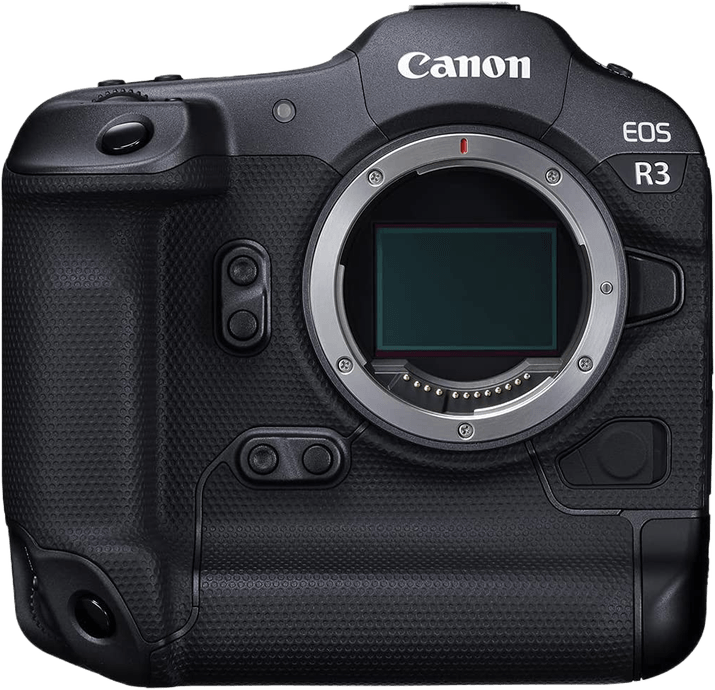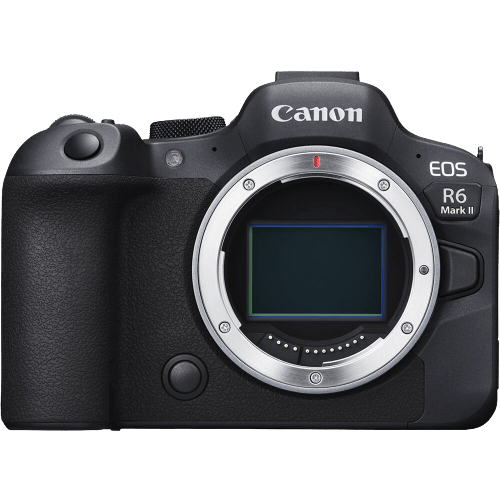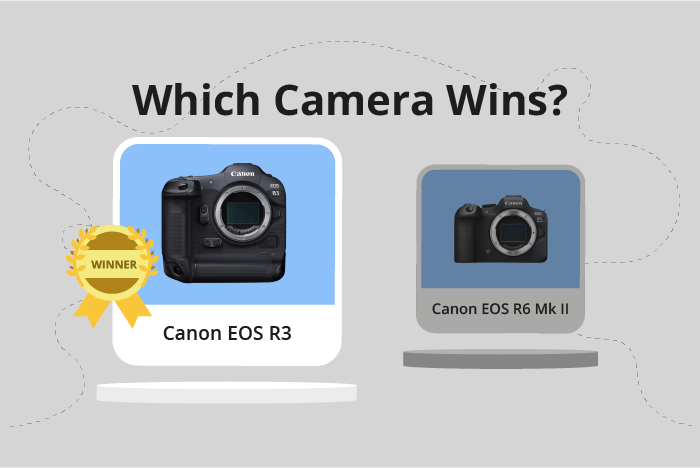Canon EOS R3 vs EOS R6 Mark II Comparison
Canon EOS R3

Canon EOS R6 Mark II

The Canon EOS R3 outperforms the Canon EOS R6 Mark II with a score of 84/100 compared to 78/100. Both cameras are mirrorless and were released recently, with the R3 in 2021 and the R6 Mark II in 2022. They share similarities in design, but the R3 excels in certain aspects.
The R3 has a larger size (150 x 143 x 87mm) and a heavier weight (1015g / 2.24lbs) compared to the R6 Mark II (138.4 x 98.4 x 88.4mm and 588g / 1.30lbs). This difference contributes to the R3’s sturdiness and durability. However, the R6 Mark II’s smaller size and lighter weight make it more portable and easier to handle for extended periods.
The R3’s higher score reflects its superior performance, but it comes at a higher launch price of $5999, while the R6 Mark II is more affordable at $2499. The R3 is the better choice for professional photographers seeking top-notch quality, while the R6 Mark II offers a more budget-friendly option without sacrificing too much performance.
Considering the scores, specifications, and price points, the Canon EOS R3 is the winner for those prioritizing performance and durability, while the Canon EOS R6 Mark II is a good alternative for those seeking a more portable and cost-effective option.
Canon EOS R3 vs EOS R6 Mark II Overview and Optics
The Canon EOS R3 wins the optics comparison with a score of 84/100, while the Canon EOS R6 Mark II scores slightly lower at 83/100. Both cameras share several specifications, including 24 megapixels, a CMOS sensor, a Digic X processor, a full-frame sensor size, a Canon RF lens mount, and image stabilization.
The EOS R3’s superior optics can be attributed to its higher DXOMARK sensor score of 96, compared to the R6 Mark II’s score of 91. This means the R3’s sensor performs better in terms of color depth, dynamic range, and low-light performance. Additionally, the EOS R3 has a shooting speed of 30 frames per second (fps), which is a good balance between capturing fast-action shots and conserving memory space.
On the other hand, the EOS R6 Mark II has a faster shooting speed of 40 fps, which allows for capturing fast-moving subjects and action scenes more effectively. However, this advantage may not be significant for some photographers, as it can result in a higher consumption of memory space and may not be necessary for certain shooting scenarios.
Considering these points, the Canon EOS R3 emerges as the better camera in terms of optics due to its higher DXOMARK sensor score and balanced shooting speed. The Canon EOS R6 Mark II, while having a faster shooting speed, falls slightly short in overall optical performance. Photographers should weigh their specific needs and shooting styles when choosing between these two cameras, but the R3 offers a more well-rounded and superior optical performance.
Canon EOS R3 vs EOS R6 Mark II Video Performance
The Canon EOS R3 outperforms the Canon EOS R6 Mark II in video capabilities, scoring 96/100 compared to the R6 Mark II’s 83/100. Despite this difference, both cameras share some common features, such as built-in time-lapse functionality. However, the R3 offers superior video quality and performance, while the R6 Mark II has some advantages of its own.
In terms of video resolution, the EOS R3 stands out with its 6K maximum resolution, offering 6000 x 3164 pixels. This is a significant improvement over the R6 Mark II’s 4K maximum resolution, which provides 3840 x 2160 pixels. The higher resolution of the R3 allows for more detailed and sharper video footage, making it a better choice for professional videographers and filmmakers.
The EOS R3 also boasts a higher maximum video frame rate of 120fps, doubling the R6 Mark II’s 60fps. This allows the R3 to capture smoother slow-motion footage and provides greater flexibility in post-production. The R3’s higher frame rate is a significant advantage for those looking to create dynamic and visually stunning videos.
While the R6 Mark II may not match the R3 in terms of video resolution and frame rate, it still delivers high-quality 4K video, making it a solid choice for enthusiasts and semi-professionals. The R6 Mark II also tends to be more affordable than the R3, making it a more accessible option for those on a budget.
Considering their video capabilities, the Canon EOS R3 is the clear winner, offering higher resolution and frame rates. However, the Canon EOS R6 Mark II remains a reliable choice for those seeking quality video performance at a more affordable price point. Ultimately, the decision lies in the user’s priorities and budget constraints.
Canon EOS R3 vs EOS R6 Mark II Features and Benefits
The Canon EOS R3 outperforms the Canon EOS R6 Mark II with a feature score of 87/100 compared to 72/100. Both cameras share several specifications, including touchscreen functionality, flip screens, GPS, WIFI, and Bluetooth capabilities.
The EOS R3 excels with its larger screen size of 3.2 inches and higher screen resolution of 4,150,000 dots, providing a clearer and more detailed display for users. These features contribute to the camera’s higher score and make it a more appealing option for photography enthusiasts seeking a better viewing experience.
On the other hand, the EOS R6 Mark II has a slightly smaller screen size of 3 inches and a lower screen resolution of 1,620,000 dots. Although these differences may not significantly impact the overall performance of the camera, they do contribute to its lower feature score. However, the EOS R6 Mark II may still be a suitable option for photographers who prioritize other aspects of camera performance or who are seeking a more budget-friendly alternative.
In comparing the two cameras, the Canon EOS R3 offers superior features in terms of screen size and resolution, which can enhance the user experience during photography sessions. The EOS R6 Mark II, while not as advanced as the R3, remains a viable option for those who may not require the highest screen specifications or are looking for a more affordable camera. Ultimately, the choice between these two cameras will depend on the individual’s priorities and preferences in camera features and performance.
Canon EOS R3 vs EOS R6 Mark II Storage and Battery
The Canon EOS R3 outperforms the Canon EOS R6 Mark II in storage and battery, scoring 81 out of 100 compared to the R6 Mark II’s 68. Both cameras share common features, including two memory card slots and USB charging capabilities. They also accept SD, SDHC, and SDXC memory cards, with the R3 supporting UHS-II and CFexpress Type B cards, while the R6 Mark II is limited to UHS-II compatibility.
The R3’s superior performance is due to its longer battery life of 760 shots and use of the LP-E19 battery type. In contrast, the R6 Mark II offers 360 shots with its LP-E6NH battery. However, the R6 Mark II still provides adequate battery life for most photography needs.
Considering these factors, the Canon EOS R3 offers a more robust storage and battery solution, while the Canon EOS R6 Mark II remains a satisfactory option for photographers with less demanding power and storage requirements.
Canon EOS R3 vs EOS R6 Mark II – Our Verdict
Are you still undecided about which camera is right for you? Have a look at these popular comparisons that feature the Canon EOS R3 or the Canon EOS R6 Mark II:

